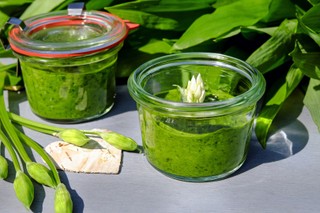11 unique ways to preserve fresh herbs (without drying them)

Having an herb garden means always having the freshest, tastiest herbs on hand for culinary projects. It also means sometimes having too many herbs to use all at once– a pretty good problem to have. We all know about drying herbs to preserve them for later use, but what about all the herbs that are better used fresh? Is it possible to preserve fresh herbs without drying them? Yes! Read on for a comprehensive look at preserving fresh herbs.
Our top takeaways:
- Many at-home herb gardeners preserve their herbs without drying them to retain the dazzling flavors that only fresh herbs provide.
- Freezing fresh herbs is the most popular and effective method, but there are many other ways to extend fresh herbs’ flavor
What makes fresh herbs better than dried herbs
Taste
Herbs are packed full of naturally-occurring chemical compounds (1) that give them their unique flavors. When herbs are dried, some of these flavorful compounds lose their potency, while other herbs (cilantro, basil) simply don’t dry very well. For that reason, using alternative preservation methods is the best way to retain the flavor these herbs lose in the drying process.
Aroma and Nutrition
The fragrance of herbs adds a dimension to the food and drink we use them in, and dried herbs simply do not have the same pungency as dry herbs. There is no comparison between the powerful smell left clinging to your fingers after pinching some fresh basil and the whiff you get when opening a jar of dried basil. The same compounds that make herbs aromatic contribute to the nutritional content of herbs. Preservation methods other than drying tend to retain higher levels of nutrients than drying.(2)
Uses
Dry herbs are fine in many sauces and dishes, but can you imagine muddling a dry herb for a cocktail or trying to make pesto with dry leaves? Of course not. There are many uses for herbs where a dried version simply will not do the trick.(3)

How to know which method to use
The honest truth about which method is best to preserve herbs is that, while certain herbs are best preserved in some specific ways, it comes down to preference and how you plan to use the herbs later. Herbs with hard, woody stems and tough leaves make good dry herbs, but tender herbs are better preserved through by other methods.

The enthusiast's guide to herbs
We’re proud to present our new e-book, The Enthusiast’s Guide to Herbs! Learn everything you need to know about growing and caring for herbs indoors, including in-depth info cards for the 35 most commonly grown herbs.
Click the link below to find out more!
How to preserve fresh herbs
1. Short-Term
For short runs of a week or so, the best way to extend the use of your herbs is to treat them like cut flowers: cute he stems at an angle using a sharp knife, and place immediately in a container of fresh water. This method is ideal for herbs purchased from the grocery store that you want to keep fresh for more than a few days. By changing the water every couple of days, and refrigerating the bouquet, it is possible to keep herbs fresh for up to two weeks.
2. Freezing Herbs
Freezing bare: The simplest way to freeze fresh herbs involves placing herbs on a baking sheet lined with parchment paper in a single layer and freezing them. To do this, first, wash and dry the herbs, then lay them on a baking sheet lined with parchment paper, and pop them in the freezer. Once they are frozen, transfer them into a freezer bag or jar for future use.
Certain herbs with woody stems, such as rosemary and thyme, are perfect frozen bare. Once frozen, place the sprigs in a bag and shake to remove the leaves from the stems. Then, pick out the stems and preserve the leaves in a container. Chives and lemongrass are also perfectly frozen this way– chop, freeze, and then store. The leaves will not stick together after they’ve been flash-frozen.
3. Making a Herbal “Cigar”
Many tender, broad-leaved herbs will not do particularly well frozen bare. The best way to freeze herbs in this category is to make them into a “cigar.” Remove leaves from stems and pack them into a freezer bag, pressing them into the bottom and then rolling the bag tightly, expressing all the air until you get to the top and seal it off. Using rubber bands to maintain the rolled-up shape, place the plastic bag in the freezer.
When you are ready to use the herbs, remove the rubber bands, open the bag, and cut off only as much of the “cigar” as you need, then re-freeze. Cilantro, chervil, parsley, sage, tarragon, and other flat-leaved herbs perform well with this method, which takes up less space in the freezer than freezing loose leaves would.
4. Freezing in Ice Cubes
Certain very tender herbs that are best used fresh can be stored in ice cube form. Mint, cilantro, lemon balm, and other herbs can be stored this way for use in recipes later. Simply place leaves chopped or whole into the cells of an ice cube tray, fill 1/2 way with water, and freeze for an hour or so. Don’t worry that the herbs will have floated to the top. After they are frozen, fill the tray to the top and freeze again.
Keeping the herbs completely encased in ice will protect them from oxidizing, preserving their color and flavor. You can transfer the frozen herb ice-cubes from the tray into freezer bags or some other sealed container for single-serving use whenever you need them. No need to thaw, cubes can be tossed directly into sauces or soups. Herbed ice cubes can also be used in cocktails, for instance, a mojito.
5. Frozen “Pesto” Cubes
Not all pesto is made from basil, although it is the first thing that tends to come to mind. Basil, oregano, marjoram, and many other herbs turn ugly and black when frozen bare. To keep these herbs their most flavorful and beautiful, freeze them in a paste, suspended in oil.
The easiest way to do this is to remove leaves from stems and then toss a cup of fresh herbs into a blender or food processor with 1/4 cup of olive oil and pulse until it is a nice, uniform mix. Pour the mixture into ice cube trays and then once frozen transfer into an airtight container for long-term storage. This can also be done with whole leaves, simply press them into ice cube trays and then cover them with oil and freeze.
6. Herbed Butter
Preparing herbed butter is an easy DIY way to preserve fresh herbs so that they are ready to be used for sautéing, spreading, or stuffing. Herbed butter is easy to make but feels utterly luxurious.
To preserve herbs in butter, use either salted or unsalted butter –it is merely a matter of personal preference. Begin by rinsing the herbs, then let them dry completely, and once dry, separate the leaves from stems. While the herbs are drying, leave the butter at room temperature so that it softens.
Mince the herbs finely and add salt or lemon zest if desired. Placing the butter and herbs in a bowl, mash them together until the mixture is completely uniform. Cut a square of parchment paper and using a spatula, place all the butter onto it. Roll the paper around the mixture to make a log shape. Fold the ends and place it in the refrigerator. Voila! You now have herbed butter.
This is a fantastic way to add a bit of flair to your food–and you can create blends suited to various cuisines. Parsley butter with lemon zest adds brightness to veggies; basil butter is a great accompaniment to scrambled eggs or fish; sage butter complements chicken or biscuits, and combinations of herbs can perform a range of culinary tasks.
Pretty much any herb can be compounded into butter. It will last a couple of weeks in the refrigerator, but can also be frozen. Frozen herbed butter will optimally be used within 2 months, but can be preserved for us to six months. Beyond that, the quality will suffer.
7. Herbed Salt
For dedicated cooks, preserving herbs with salt is a deeply satisfying way to preserve the season and lend rich flavoring to savory foods simply–with salt. The addition of garlic creates a spice mix that is perfectly balanced and dry-preserved without requiring a dehydrator or special equipment.
Begin with half a cup of kosher salt, two cups of pungent fresh herbs–rosemary, thyme, savory, and sage are an ideal combination–and four to five peeled cloves of garlic. Using either a food processor or a chef’s knife, mince the garlic with two tablespoons of salt. Add the herbs to the food processor or chopping board and chop them until the mixture is the texture of coarse sand.
Spread the mixture over a baking sheet and sprinkle the remaining salt over it. Leave it in a sunny spot near a window for a couple of days to dry out, and then transfer it into clean, dry mason jars. This salt is delicious on popcorn, fried eggs, potatoes–pretty much anything. It makes a great gift and can be stored for a year or more– if it lasts that long.
8. Salt-Preserved Herbs
Our ancestors who lacked refrigerators knew how to preserve herbs without fancy equipment, and salt-preserving was one of their go-to methods. Delicate, tender herbs that dry poorly are perfect for this method. Consider preserving basil, cilantro, chives, dill, parsley, or tarragon this way. All you need is a clean, dry glass jar, fresh herbs, and some kosher salt.
Begin by sprinkling a layer of salt in the bottom of the jar, then lay a single layer of herbs, then salt, and continue until the jar is full. Keep the jar in a cool, dark place, like a pantry shelf or even the refrigerator, and pull out herbs as you need them, shaking or rinsing the salt off if you wish. When you are finished with the herbs, the salt will have retained the herb flavor, so can be used in cooking or pickling. This method of preservation should keep herbs fresh and usable for a minimum of six months, but likely up to a year.
9. Herbed Sugar
Far too often, we assume that herbs play exclusively savory roles in cooking. This is completely unfair to herbs, evidenced by this next method of preservation: herb-flavored sugar. Using the exact same technique as salt-preserving, layer fresh herbs with sugar to infuse the sugar with a delicate flavor and preserve herbs for separate use. It is also possible to use a food processor to mince herbs into sugar.
Consider herbs like mint, lemon balm, lavender, rosemary, thyme, or sage. Leave the glass jar in a cool, dark place or the refrigerator, and use it for baking, cooking, and cocktails. This method should preserve herbs for up to a year.
10. Herbal Honey
Honey is a natural preservative–it’s antibacterial, anti-fungal, and has antiviral properties. It can also keep the flavors of herbs alive for over a year. To preserve herbs in honey, it is best to use a honey that is local and not strongly flavored (some honey from seasonal flowers will have its own flavor).
Simply place your herbs whole or minced into a clean glass jar and cover with honey. Let the infusion sit for a minimum of six weeks for the flavors to deeply penetrate, and then use to sweeten tea, as a syrup topping, in baking, or even as a base for a meat glaze.
11. Infused Vinegar
Herb-infused vinegar is nothing new, but it’s an easy way to preserve the flavor of your herbs for long periods of time and makes a lovely gift. The trick is to start with a lighter vinegar such as a champagne vinegar, white wine vinegar, or other light-hued vinegar.
Use well-cleaned glass canning jars and a handful of herbs. Divide sprigs equally between the jars, and then pour vinegar over the sprigs, leaving at least a quarter-inch of space at the top. Screw on lids and store them in a cool, dark place for a month or so. When you are ready to use, strain the vinegar through a cheesecloth to remove any sediment. Pour vinegar into glass bottles and add a decorative sprig or two if you like. These kinds of vinegar make great salad dressings and marinades and will keep indefinitely.
As you can see, there are many alternatives to drying to make your fresh herbs last many seasons. Never let an herb harvest or purchase go to waste again!

Join our email club—get printable info cards free!
Sign up to receive our newsletter and get access to 10 printable plant info cards from our e-book for free. Also receive:
- $4 discount code for our Guide to Herbs e-book
- Semi-weekly plant inspiration & bite-size tips and tricks


